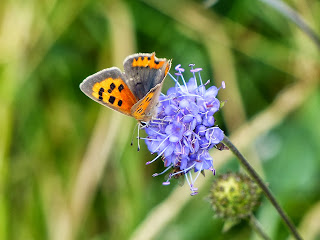The meadow was also sown to ensure a range of early hay meadow species were out before the garden plants came into flower, such as Buttercup, Red Campion, Sneezewort, Ox-eye Daisy, Ragged Robin, Knapweed and Wild Carrot.
Several species of bee were seen daily, particularly on the Lavender. Buff-tailed, White-tailed, Red-tailed, Common Carder, Garden and Early being the most frequent visitors.
The small pond was built and stocked with a range of species from the NNR – Purple Loosestrife, Water and Corn Mint, Yellow Flag Iris, Round-leaved Pondweed, Sneezewort, Water Plantain and Great Water Parsnip – again to provide a natural range of Ings marginal water plants for a number of inverts especially dragonflies. A number of dragonflies have been seen on the small pond with species such as Broad-bodied Chaser, Brown Hawker, Ruddy Darter and Common Darter seen regularly.
The feeding station which was built in February this year saw plenty of activity as winter came to a close. The feeders were left empty throughout the breeding season but last month in preparation for the winter the feeding station was set up again and has seen a lot of activity already. Tree Sparrows in particular have been making good use of it, along with Willow and Marsh Tits, Brambling, Chaffinches and a Great Spotted Woodpecker often comes down for the peanuts.
The NNR Base has also become home to several pairs of breeding Tree Sparrows which is especially pleasing for a species which is on the amber list.
Several Long-eared Bats and Pipistrelle Bats have also made the base their home, and artificial House Martin nests and Swift bricks have also been used - albeit by Wrens and Tree Sparrows - maybe next year!
For us whilst it is great to have a reserve base that is fit for purpose and that allows efficient delivery of the NNR management and additional outreach benefits, it is however also a real bonus and asset to Natural England to have a demonstration green build, complete with its new inhabitants, and one that adds to the experience of visitors coming to the NNR. To see how the garden has developed this year has been a rich reward for those involved with developing it, particularly for our volunteers that have helped plant it, weed it and survey the wildlife in it!





















































